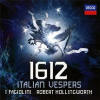Texte paru dans: / Appeared in:

Fanfare Magazine:
Pour
s'abonner / Subscription information
Les abonnés à Fanfare Magazine ont accès aux archives du
magazine sur internet.
Subscribers to Fanfare Magazine have access to the archives of the magazine
on the net.
Decca
4783506

0028947835066 (ID235)
Consultez toutes les évaluations recensées pour ce cd
~~~~ Reach all the evaluations located for this CD
Another program that more or less reconstructs a historical event, as we just noted last issue under Lo Sposalizio, this one is a celebration of the feast of the Most Holy Rosary following the battle of Lepanto in 1571, which turned the tide of Turkish control of the Mediterranean. This reconstruction dates from the publication by Ludovico Grossi da Viadana in 1612 of the five psalms for Vespers of the Blessed Virgin heard here. The victory of the allied navies commanded by Don Juan of Austria was attributed to prayers to the Virgin Mary using the popular devotion of the rosary, and the result was the establishment of the feast of the Most Holy Rosary on the date of the battle, October 7. (The feast was originally called Our Lady of Victory.) Robert Hollingworth has filled out the celebration of Vespers with music by six other composers, noting that Giovanni Gabrieli died in that year. This is not a reconstruction of a particular moment in time but only of a festal celebration in northern Italy when the music of these composers was in general use.
Viadana’s psalms and opening versicle are set for four choirs. Hollingworth has distributed his forces to provide voices with theorbo and organ on choir I, voices only on choir II, and instruments with organ accompaniment on choirs III and IV. The Magnificat for 20 (and 28) voices is largely reconstructed by Hugh Keyte after surviving parts by Giovanni Gabrieli. The Vespers is followed by a motet, his In ecclesiis for four choirs, partly reconstructed as well. The psalms and canticle are preceded by chant antiphons, the usual group for Marian feasts, and followed by a series of antiphon substitutes by Bartolomeo Barbarino, Andrea Gabrieli, Viadana himself, Palestrina, and Monteverdi. All are vocal or choral except the fifth, an organ toccata by Andrea Gabrieli. The last substitute antiphon is Monteverdi’s “Ab aeterno ordinata sum.”
This disc
is a conscious follow-up to Hollingworth’s previous disc of Striggio
(Fanfare 35:1; but see also 35:6). Again he adds the English Cornett and
Sackbut Ensemble to his regular forces, and this time he uses a Cambridge
schola, De Profundis, for the chants. The contents show in detail how the
singers and players are assigned for each track. For example, the hymn is
the familiar Ave maris stella for Marian Vespers, so verses 1 and 7 use
Monteverdi’s 1610 setting, verses 2, 4, and 6 use one by Francesco Soriano
(with only three strings in verse 6), and verses 3 and 5 use the chant
setting that underlies the rest. All the singers and players execute with
loving precision. The service of Vespers is completed with capitulum,
versicle, and collect, small parts that are always chanted. Despite the
diverse sources of the various parts (a normal way to sing a liturgical
Office), they blend in a satisfying whole. A photo taken from the west
gallery shows the performing forces assembled in the gothic space of St.
John’s, Upper Norwood, suggesting a venue that suits the music perfectly.
Intelligently conceived, neatly executed, this disc exemplifies the turn of
the 17th century in an original way.
Fermer la fenêtre/Close window
Cliquez l'un ou l'autre
bouton pour découvrir bien d'autres critiques de CD
Click either button for many other reviews


